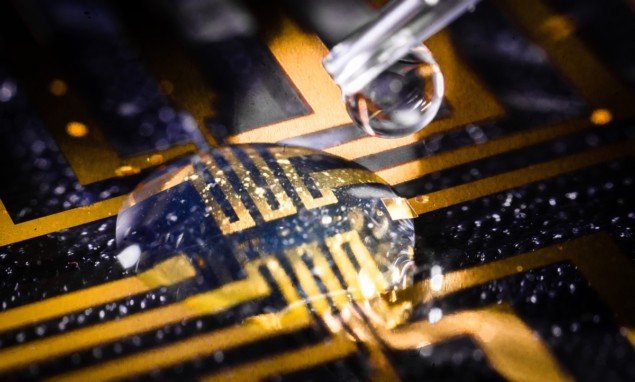Researchers grow electronics directly inside living tissue
06 Mar 2023 Tami Freeman
A complex cocktail The injectable gel being tested on a microfabricated circuit. (Courtesy: Thor Balkhed)
Interfacing neural tissue with electronics provides a way to investigate the complex electrical signalling characteristics of the nervous system. Implanted electronic devices can also be used to modulate neural circuitry to prevent or treat various diseases. Unfortunately, there’s a fundamental mismatch between rigid electronic substrates and soft tissues that risks damage to delicate living systems.
Researchers in Sweden have come up with a way around this mismatch, by generating electrodes within the body. The team – from Linköping University, Lund University and the University of Gothenburg – has developed a method of creating soft, substrate-free conducting materials directly inside living tissue, using the body’s molecules as triggers.
The approach, described in Science, starts with an injectable solution made from a complex cocktail of molecular precursors. This gel contains an organic monomer known as ETE-COONa, as well as oxidase enzymes (glucose oxidase (GOx) or lactate oxidase (LOx)) and horseradish peroxidase embedded in a polymer matrix along with crosslinkers. After injection, the enzymes break down endogenous metabolites in the tissue (glucose or lactate), inducing polymerization of the organic monomer to form a stable, soft conducting gel.
“For several decades, we have tried to create electronics that mimic biology. Now we let biology create the electronics for us,” says Linköping University’s Magnus Berggren in a press statement.
In vivo electrode fabrication
Berggren and colleagues validated the enzyme-triggered polymerization process by injecting the cocktail gels into anaesthetized live zebrafish. Gels injected into zebrafish tailfins polymerized in vivo, creating a distinct dark colour along the whole length of the fin cavities. Both glucose and lactate were effective catalysts, with lactate inducing faster polymerization, likely due to its higher concentrations in zebrafish tissues.
The team next injected the cocktail with LOx as the oxidase enzyme into the brains of anesthetized zebrafish, work conducted by Roger Olsson from Lund University. Dissected brain slices contained dark blue polymer, indicating signs of polymerization, which the researchers confirmed via UV-vis absorption spectroscopy.
They characterized the electrical behaviour of the brain slices by placing them on top of gold microelectrode arrays (MEAs) and performing measurements in regions with dark spots. Dehydrated brain slices exhibited a linear current when a voltage of between −0.5 and 0.5 V was applied. This current was higher than seen in control tissue samples.
Importantly, the LOx-based gels appeared to be nontoxic. Three days after gel polymerization in the brain, the zebrafish showed normal swimming behaviour and the injection site had no signs of tissue damage.
Injecting GOx-based cocktail gels into the zebrafish brains did not cause polymerization. This poor performance was expected because zebrafish brains, much like their human counterparts, are known to have low glucose and high lactate concentrations. Linköping team Xenofon Strakosas, Magnus Berggren, Daniel Simon and Hanne Biesmans discuss their research. (Courtesy: Thor Balkhed)
Linköping team Xenofon Strakosas, Magnus Berggren, Daniel Simon and Hanne Biesmans discuss their research. (Courtesy: Thor Balkhed)
 Linköping team Xenofon Strakosas, Magnus Berggren, Daniel Simon and Hanne Biesmans discuss their research. (Courtesy: Thor Balkhed)
Linköping team Xenofon Strakosas, Magnus Berggren, Daniel Simon and Hanne Biesmans discuss their research. (Courtesy: Thor Balkhed)The researchers also immersed extracted zebrafish hearts in GOx- or LOx-based cocktail gels. For both gels, they observed dark blue lines on the surface of the hearts, indicating that both glucose and lactate induced polymerization. Hearts removed from the gel and integrated with MEAs exhibited a linear current response to the application of a linear voltage sweep, a behaviour not seen in control samples.
These findings demonstrate that the formation of electronic conductors fuelled by endogenous metabolites can develop soft electronics in various biological tissues and environments. To confirm this, the researchers injected the gels into beef, pork, chicken and tofu samples. They observed polymerization in all of the tissues, but not in the plant-based tofu, due to the lack or low concentration of the required metabolites.
Finally, to investigate the possibility of creating recording and stimulation electrodes for neuroscience applications, the team injected the gel into medicinal leeches, which have a simple and easily accessible nervous system. They showed that LOx-based cocktails polymerized in situ and could interface nervous tissue with gold electrodes on a tiny flexible probe.READ MORE

“Our results open up for completely new ways of thinking about biology and electronics,” says co-lead author Hanne Biesmans, a PhD student at Linköping’s Laboratory of Organic Electronics. “We still have a range of problems to solve, but this study is a good starting point for future research.”
Berggren says that the team’s current aims include varying the cocktail chemistry to control the binding locations, providing a tool to build up electrodes and electronics at the cell level. “We are also evaluating the cocktails, and modifications thereof, in other larger animal models, to enable contact to external circuits, then to achieve recording or actuation of neuronal signalling,” he tells Physics World.

Tami Freeman is an online editor for Physics World
FROM PHYSICSWORLD.COM 9/3/2023

Δεν υπάρχουν σχόλια:
Δημοσίευση σχολίου